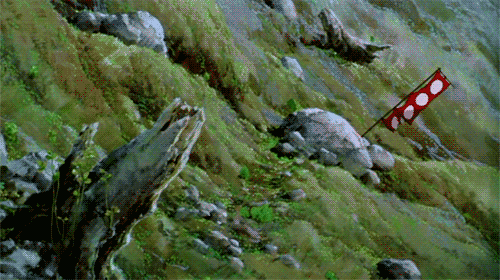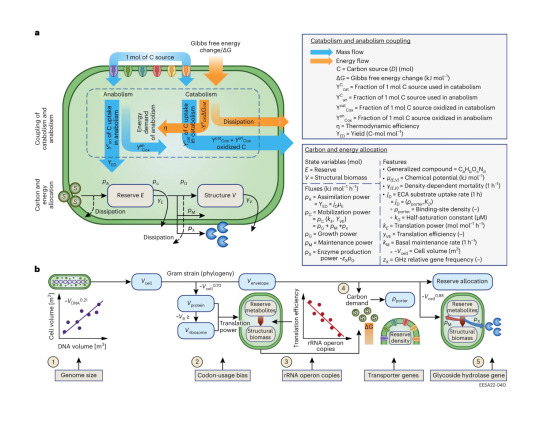#Earth 🌍
Explore tagged Tumblr posts
Text
All Life On Earth Might Have Started From Lightning, Scientists Say. It’s Electric!
— By Darren Orf | August 06, 2024

Victor de Schwanberg/Science Photo Library//Getty Images
For decades, scientists have theorized that volcanic lightning on an early Earth played a crucial role in kickstarting life on the planet by breaking molecules into useful, biological components.
A new study from Harvard University suggests that cloud-to-ground lightning—as opposed to other theories like cloud-to-cloud lightning or panspermia—likely provided the necessary material for the first organisms to form.
This discovery could help scientists better understand the chemistry of early Earth life forms, and provide a template for how life could start on planets beyond our own.
“How did life begin?” is one of the most profound scientific questions ever pondered. And it makes sense that such a grand idea would inspire many possible theories and explanations—both data-driven and divine. Focusing on the former, one of the most popular theories is the concept of “panspermia”—that ancient asteroids colliding into early Earth brought with them the building blocks (or even the microorganisms themselves) necessary to kickstart life.
However, there’s another theory that doesn’t rely on some extraterrestrial origin: cloud-to-ground lightning strikes.
In 1953, American scientists Stanley Miller and Harold C. Urey conducted the first experiments investigating whether lightning strikes could instigate the production of amino acids by simulating the conditions of early Earth. Now, scientists from Harvard University have discovered how cloud-to-ground lightning strikes—especially volcano-produced ones—could’ve created the necessary ingredients for life more efficiently than panspermia or even cloud-to-cloud lightning strikes. The results of the study were published in the journal Proceedings of the National Academy of Sciences (PNAS).
“The emergence, survival, and evolution of biology require dependable sources of nitrogen and carbon,” the paper reads. “Lightning-induced plasma electrochemistry could have generated high concentrations of nitrogen- and carbon-containing feedstocks locally and produced a range of reagents globally that were relevant (and crucial) to emergent life.”
Similar to the famous Miller-Urey experiment in 1953, the team simulated the conditions of early Earth in a laboratory, and studied the chemical reactions when simulated lightning strikes struck air, land, and water replicas. The results showed that carbon dioxide transformed in the carbon monoxide and formic acid—previously regarded as a “ubiquitous but overlooked component of the early Earth atmosphere.” But crucially, nitrogen (N2) would’ve also converted into nitrates, nitrites, and ammonia.
This is extremely important, as Earth’s early atmosphere would’ve been made up of nonreactive N2 molecules. Lightning was the essential piece needed to create the ingredients essential for forming things like DNA, RNA, and proteins. A 2023 study from the University of St. Andrews in Scotland found that the metabolism of ancient microorganisms soon found ways to break N2 gas into usable ammonia, but that lightning provided the crucial first step to really get the process going. Now, this new discovery is another strong piece of evidence pointing towards life’s electrifying beginnings—and another nail in the coffin of the long-shot theory of panspermia.
Scientists may never know for sure exactly how life started those many billions of years ago. But it seems increasingly likely that when it comes to creating life, Earth had it in her all along—and that it may not have been the only planet in our Solar System capable of such a feat.
1 note
·
View note
Text
🌱𝐄𝐀𝐑𝐓𝐇 𝐌𝐎𝐍𝐓𝐇🌳










❤️🌍
#studioghiblimiyazakihayao#studio ghibli#earth month#❤️#save the earth#🌍#save the planet#spirited away#my neighbor totoro#howl's moving castle#ponyo on the cliff by the sea#ghibli gif#prinsess mononoke#anime gif#whisper of the heart#laputa castle in the sky#hakuchihiro#the wind rises
522 notes
·
View notes
Text
Guys what kind of Cale do you like best.... Cale's Era's

#trash of the count's family#tcf#cale henituse#tcf cale#kim rok soo#commander Cale henituse#priest Cale henituse#naru#kim roksu#earth 2 🌍#Era's#Which Cale
2K notes
·
View notes
Text








❝ And KENDALL needs to stop talking back to me after everything I say! ❞
#WOE INAUGURAL TRASH BLOG REVIVAL KENDALL KNIGHT GIFS BE UPON YE!!!!! IT'S ONLY RIGHT OFC PEACE AND LOVE ON PLANET EARTH 💖🕊️🌍#i hope this atones for all the immediate shitposting i did right outta hiatus;;; the shitposting will continue though but still#i'm not even capping i have so many random solo kendall gifsets that i never posted. the chokehold this man and his eyebrows had on me 🐕#also heck it why not i'm leaving the embarrassingly unhinged og (2022?) tags i had for this post as well here are They:#TOP TEN DEVASATING INCIDENTS THAT GOT ME HOLLERING HE'S MY BABYGIRL FR DOT GEE EYE EFF!!!!!!#THAT 3RD GIF SPECIFICALLY GOT ME ACTING UP SOME KINDA WAY;;; PURE ATTITUDE ALL WRAPPED IN SASSY FLANNEL DIMPLY BITCH BOY UGH HE'S SO VERY !#'Chill pill!' bro was so proud of getting the last word that gustavo made sure it ended up on his gravestone 💀💀💀#brb omw to be kendall knight's b-b-b-b-b-boyfriend <3 that's what that song was about right he's looking for a one so babyyy imma be that#idk if this is any good it's my first time attempting gifs in gīmp and i have zero idea .-. the filter is babygirlifying ken good tho#but it also looks like some fever dream mf sequence which um. isn't too far off from what my subconscious mostly looks like tbh :^/#i prolly shoulda grided this bUT DANGIT I SPENT TOO LONG ON THIS AND MY MANS BEAUTIFUL FACE DESERVES TO BE APPRECIATED IN 4KHD SOZ LONGPOST#if it looks like a mushy grainy dithering mess with 4 pixels across the boards that's on tumblr so pls click on it hopefully it's better???#btr#big time rush#kendall knight#kendall schmidt#s02e08: big time guru#all my btr episodes are locked away and i can't fact-check if that's the right one so i really hope i'm remembering it right ༎ຶ ෴ ༎ຶ#edit#tvedit#gifs#gifset#btrgifs#rusher#mine#turn that thing big time!#my rusher besties aren't really on tumblr but imma use their friendship tags anyway bc. i Love them sm 🫶 kenny is liz hehe#stop it forever#big time eps#tv gifs
30 notes
·
View notes
Text
NANOLATHE BODY MORPHING LIFE SUPPORT
🔎🛡️🌟🇬🇧🇺🇲🌏🌎🌍🇺🇲🇬🇧🌟🛡️🔍
#NANOLATHE BODY MORPHING LIFE SUPPORT#life support#life extension#military defenses#planet earth#paul atreides#prince william#roman reigns#jesus#🔎🛡️🌟🇬🇧🇺🇲🌏🌎🌍🇺🇲🇬🇧🌟🛡️🔍
91 notes
·
View notes
Text
The sahara desert has flooded.
The US has just had 3 cat 5 hurricaines, one of which has defied the mathematical laws of a cat 5 and is possibly a new cat 6. For the majority of hurricane Katrina, it was only a category 3. Volcanoes are erupting in Iceland. Hurricaine Kirk is hitting europe as a cat 4-5. Idaho is on fire. Our earth is dying and nobody cared until it is now becoming too late.
The fossil fuels being put into our earths O Zone layer are melting the antarctic and with the rising sea surface temperatures are fuelling the intensity of hurricanes, and the warmer atmosphere can carry more water. Major companies are killing our only earth and they do not care.
The growing frequency of climate change related disasters such as wildfires, floods, hurricanes, etc increased the chances that volcanoes will erupt.
Climate change disaster news will slowly be filmed closer and closer to you until you’re the one filming it. It is a real problem that is happening in real time.
#climate change#help#warning#serious post#tumblr fyp#earth#🌍#hurricane helene#hurricane milton#hurricane#volcano#wildfire#climate action#climate crisis
15 notes
·
View notes
Text
why is it that people on here r so quick to b like "oh you silly autists!!!!!!!!! you have to do *completely arbitrary social rule* or else everyone will hate you and you will die!!!" like speak for urself but I'm friends w people who understand me and respect me...
#when someone says autists i get to put another dollar into my fund for a giant bomb that will kill everyone on earth 🌍🌎#(my cute way of saying i hate it)
9 notes
·
View notes
Text
. * . * .🌕 * . * ☄️. * * . 🌍* . . * ⭐️ * . * . . *. ✨
* . * 💫 . * * . * 🪐 . * * . * . *🌟 * . *
#omawi36#supernatural#dandadan#dark academia#artists on tumblr#art#star wars#⭐️rving#✨.txt#✨#stars#earth#🌎#🌍
7 notes
·
View notes
Text

Some sister-brother time!!
(0:25) C'mon! You two can do it in time!
(1:51) ptf- 🤭
(2:35) 🤭
(2:45) They repeating the same thing is funny and cute!🤭
(3:32) Sunny? You good?🤭
(4:53) Sun little surprised sounds are so cute and funny!🤭
(5:57) Nuu, it looks nice!
(6:25) Bet you do!🤭
(7:06) Yeaaah, and I bet you do some delicious food!😋
(7:45) "I'm still standing after all this time!"~ 🎵 🎶(kinda suit him this song!)
(8:00) Yep, you should believe in yourself more!
(8:20) OH MY GOD, SEE!! YOU DID IT!!
(8:33) CONGRATSSS SUNN!!!! YOU DID GREAT!!!🤩🤩
(9:29) YOU DO DESERVE THIS!!!😄😄
(13:53) 🤭🤭🤭
(14:08) 😂😂😂
(16:34) I love when they sing like this!❤
(17:45) YOU WOONNN EARTH!!!! CONGRATS!!!!🤩🤩
I loved watching them playing this game, it was really nice!!! Sister-brother best bond ever!!
(Btw, I love Sun's shirt in the thumbnail ❤)
#fnaf#fnaf daycare attendant#fnaf security breach#sun and moon show#sams#fnaf sb#funny#eals#earth and lunar show#cute#BEST SISTER-BROTHER DUO EVER!!!!☀️🌍
17 notes
·
View notes
Text






Feeling grateful for life today, since it wasn't cut short
(eventhough life on earth is short as it is... let me never run out of August beaches, being with the people of my life, and orange honeypot sunsets)
#Life still likes to hang out with me! I'm glad#🤝❤️🌍 don't spit me out yet @ earth. i have laundry to do and to be bummed out with my dog when i bathe her after she rolled in dead rat#The sight of the crash still fucks with me (no details). I just have to deal with it and process that#Also continue driving myself and not shy away from stepping into the car
15 notes
·
View notes
Text

Drawing dump from a slideshow I made recently


added too much zest to the one on the right and his tits are too big and he looks like a lesbian



FOUND IN DRAFTS. ORIGINAL POSTING DATE 14/07/24
2 notes
·
View notes
Text
Improving Climate Predictions By Unlocking The Secrets of Soil Microbes
— By Julie Bobyock, Lawrence Berkeley National Laboratory | February 5, 2024

Overview of DEBmicroTrait. Credit: Nature Microbiology (2024). DOI: 10.1038/s41564-023-01582-W
Climate models are essential to predicting and addressing climate change, but can fail to adequately represent soil microbes, a critical player in ecosystem soil carbon sequestration that affects the global carbon cycle.
A team of scientists led by the Department of Energy's Lawrence Berkeley National Laboratory (Berkeley Lab) has developed a new model that incorporates genetic information from microbes. This new model enables the scientists to better understand how certain soil microbes efficiently store carbon supplied by plant roots, and could inform agricultural strategies to preserve carbon in the soil in support of plant growth and climate change mitigation.
"Our research demonstrates the advantage of assembling the genetic information of microorganisms directly from soil. Previously, we only had information about a small number of microbes studied in the lab," said Berkeley Lab Postdoctoral Researcher Gianna Marschmann, the paper's lead author.
"Having genome information allows us to create better models capable of predicting how various plant types, crops, or even specific cultivars can collaborate with soil microbes to better capture carbon. Simultaneously, this collaboration can enhance soil health."
This research is described in a new paper that was recently published in the journal Nature Microbiology. The corresponding authors are Eoin Brodie of Berkeley Lab, and Jennifer Pett-Ridge of Lawrence Livermore National Lab, who leads the "Microbes Persist" Soil Microbiome Scientific Focus Area project.
Seeing the Unseen: Microbial Impact on Soil Health and Carbon
Soil microbes help plants access soil nutrients and resist drought, disease, and pests. Their impacts on the carbon cycle are particularly important to represent in climate models because they affect the amount of carbon stored in soil or released into the atmosphere as carbon dioxide during the process of decomposition.
By building their own bodies from that carbon, microbes can stabilize (or store) it in the soil, and influence how much, and for how long carbon remains stored belowground. The relevance of these functions to agriculture and climate are being observed like never before.
However, with just one gram of soil containing up to 10 billion microorganisms and thousands of different species, the vast majority of microbes have never been studied in the lab. Until recently, the data scientists had to inform these models came from only a tiny minority of lab-studied microbes, with many unrelated to those needing representation in climate models.
"This is like building an ecosystem model for a desert based on information from plants that only grow in a tropical forest," explained Brodie.
The World 🌎 Beneath Our Feet 🦶🦶
To address this challenge, the team of scientists used genome information directly to build a model capable of being tailored to any ecosystem in need of study, from California's grasslands to thawing permafrost in the Arctic. With the model using genomes to provide insights into how soil microbes function, the team applied this approach to study plant-microbiome interactions in a California rangeland. Rangelands are economically and ecologically important in California, making up more than 40% of the land area.
Research focused on the microbes living around plant roots (called the rhizosphere). This is an important environment to study because, despite being only 1-2% of Earth's soil volume, this root zone is estimated to hold up to 30-40% of Earth's carbon stored in soils, with much of that carbon being released by roots as they grow.
To build the model, scientists simulated microbes growing in the root environment, using data from the University of California Hopland Research and Extension Center. Nevertheless, the approach is not limited to a particular ecosystem. Since certain genetic information corresponds to specific traits, just as in humans, the relationship between the genomes (what the model is based on) and the microbial traits is transferable to microbes and ecosystems all over the world.
The team developed a new way to predict important traits of microbes affecting how quickly they use carbon and nutrients supplied by plant roots. Using the model, the researchers demonstrated that as plants grow and release carbon, distinct microbial growth strategies emerge because of the interaction between root chemistry and microbial traits.
In particular, they found that microbes with a slower growth rate were favored by types of carbon released during later stages of plant development and were surprisingly efficient in using carbon—allowing them to store more of this key element in the soil.
The Root of the Matter
This new observation provides a basis for improving how root-microbe interactions are represented in models, and enhances the ability to predict how microbes impact changes to the global carbon cycle in climate models.
"This newfound knowledge has important implications for agriculture and soil health. With the models we are building, it is increasingly possible to leverage new understanding of how carbon cycles through soil. This in turn opens up possibilities to recommend strategies for preserving valuable carbon in the soil to support biodiversity and plant growth at scales feasible to measure the impact," Marschmann said.
The research highlights the power of using modeling approaches based on genetic information to predict microbial traits that can help shed light on the soil microbiome and its impact on the environment.
#Biology 🧬 🧪#Ecology#Cell & Microbiology 🧫#Nanotechnology#Physics#Earth 🌍#Astronomy 🪐 🔭 & Space#Chemistry 🧪 ⚛️#Other Sciences#Medicine 💊#Technology#Phys.Org#Julie Bobyock | Lawrence Berkeley National Laboratory 🥼 🧪#Almeda County | California | USA 🇺🇸
0 notes
Text

#STAR TREK - FILM RELEASED IN THE YEAR 2009 ON THE PLANET NAMED EARTH - PLANET EARTH - 🌍🌎🌏🌐#star trek#star trek 2009#time travel#walking#time travel on foot#STORMTROOPERS#stormtrooper#square military rank insignia#square military rank insignia militaries#shakespeare#paul atreides
4 notes
·
View notes
Text

Landscape from the south of New Caledonia
15 notes
·
View notes
Text
Do you want to see our earths coral reefs one day?
Well then you’re gonna need to start realising how serious climate change is.
Our warming ocean due to the fossil fuels being put into our O Zone layer are causing thermal stress to the beautiful wonders that are coral reefs (which also keep our oceans alive) are causing bleaching and are killing our coral reefs. The main contributors to putting fossil fuels in our O Zone layer are major corporations that we people use on an every day basis.
If you would like to see the coral reef’s one day - sign this.
https://preserve.nature.org/page/81465/petition/1?locale=en-US
#climate change#coral reef#uk#fossil fuels#🌍#earth#hurricane milton#hurricane helene#great barrier reef#tourism#climate action#climate crisis
3 notes
·
View notes

